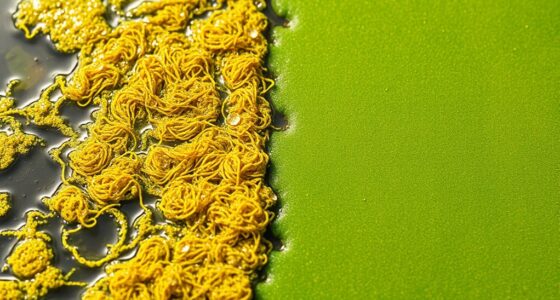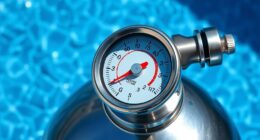To manage high calcium fill water long-term, consider installing water softening systems like ion exchange or chemical softeners to prevent scale buildup. Regularly maintain your plumbing with inspections and cleaning, and use corrosion-resistant pipes to prolong lifespan. Incorporate reverse osmosis units for extra purity and monitor water quality consistently to catch issues early. Adopting sustainable practices like reuse and leak prevention can also help. Continued strategies can guarantee your system stays efficient and durable over time.
Key Takeaways
- Install water softening systems like ion exchange or chemical softeners to reduce calcium levels long-term.
- Use corrosion-resistant piping materials such as PVC or stainless steel to prevent scale buildup.
- Incorporate scale inhibitors and regular system flushing to minimize mineral deposits inside plumbing.
- Conduct routine water quality testing to monitor calcium levels and adjust treatment strategies proactively.
- Optimize system design with bypass loops and maintenance-friendly components to facilitate ongoing cleaning and scaling prevention.
Understanding the Impact of High Calcium Levels

High calcium levels in fill water can cause several problems that directly affect your plumbing and appliances. When calcium concentrations are high, mineral deposits, known as scale, start to build up inside pipes, fixtures, and appliances like water heaters and dishwashers. This buildup reduces water flow and makes appliances less efficient, increasing energy and maintenance costs. Over time, the scale can cause blockages, corrosion, and even pipe leaks. You might notice reduced water pressure, stained fixtures, or appliances that don’t operate properly. These issues not only lead to costly repairs but also shorten the lifespan of your plumbing system. Understanding these impacts helps you recognize the importance of addressing high calcium levels early to protect your home’s plumbing health. Additionally, high calcium levels can contribute to environmental issues such as deforestation and ecosystem disruption when water sources are overused or contaminated, highlighting the need for sustainable water management practices.
Implementing Water Softening Technologies
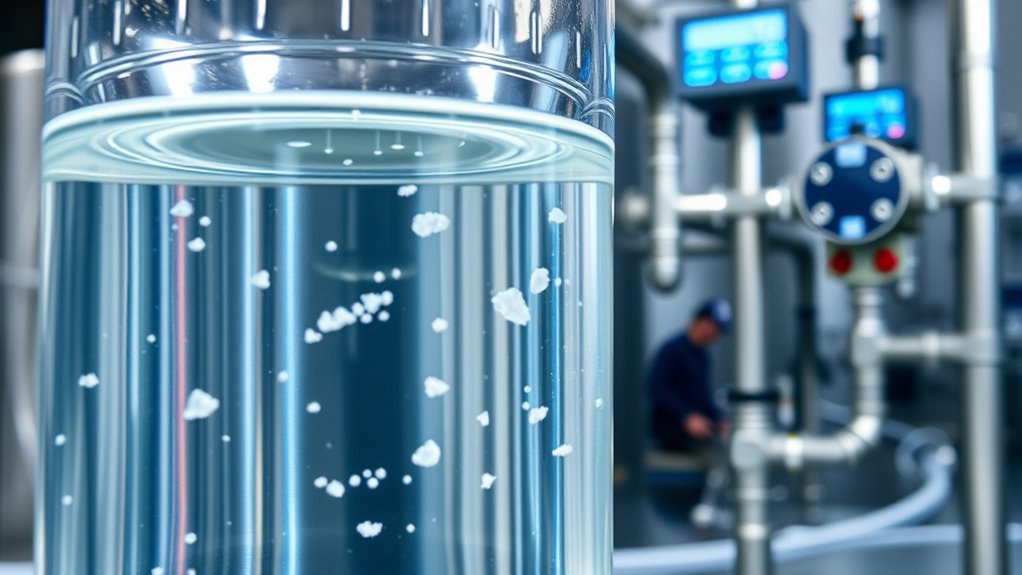
To effectively combat the problems caused by high calcium levels, implementing water softening technologies is vital. You can start by installing ion exchange softeners that replace calcium ions with sodium or potassium, reducing hardness. Regular maintenance is indispensable—resin regeneration ensures consistent performance. Consider automatic systems that monitor water quality and trigger regeneration when needed. If you prefer a chemical approach, you might add water softening salts or conditioners to prevent scale buildup. For larger operations, multi-stage systems combine different softening methods for better results. Always evaluate your water usage and calcium levels to choose the right technology. Proper implementation not only improves water quality but also extends the lifespan of appliances and plumbing, making your long-term solution more effective and economical. Additionally, understanding your water’s hardness level can help you select the most suitable softening method for your specific needs.
Utilizing Reverse Osmosis Systems for Purity
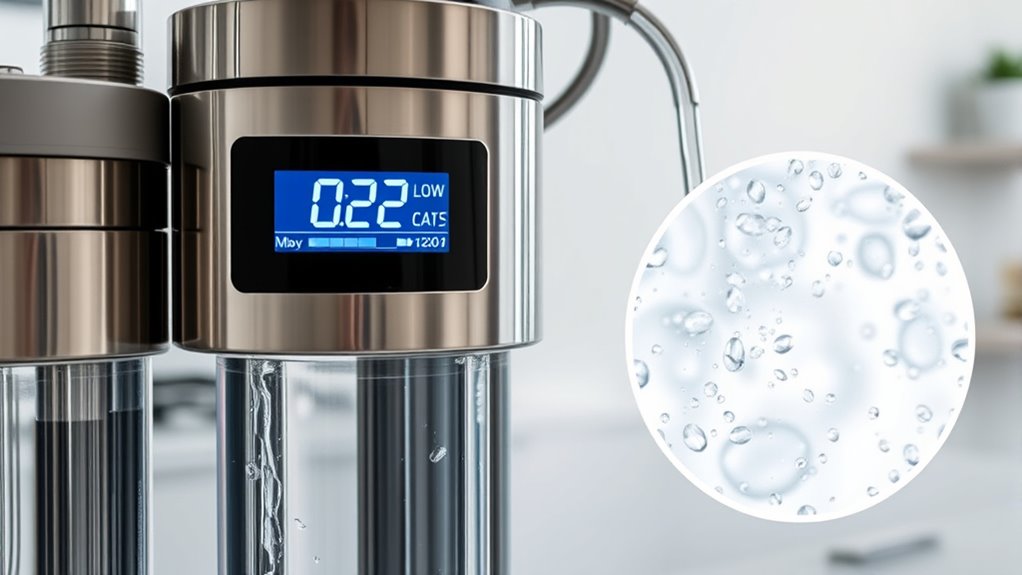
Using a reverse osmosis system can substantially improve your water purity by removing calcium and other contaminants. You’ll benefit from cleaner, better-tasting water, but it’s important to understand the system’s maintenance needs. Staying on top of filter replacements ensures your system works efficiently and provides the best results. Regular maintenance and occasional system upgrades can further optimize performance and longevity. Hyundai Tuning
Reverse Osmosis Process
Reverse osmosis systems are highly effective at removing excess calcium and other impurities from fill water, ensuring it’s clean and safe for use. The process works by forcing water through a semi-permeable membrane that traps contaminants, including calcium, heavy metals, and dissolved solids. As water passes through the membrane, pure water molecules move to the other side, leaving behind impurities. Pre-filters often remove larger particles before water reaches the membrane, extending its lifespan. The system typically includes a storage tank for purified water, and a post-filter may improve taste and odor. Regular maintenance, such as replacing filters and membranes, keeps the system functioning efficiently. Overall, reverse osmosis provides a reliable, long-term solution for reducing calcium levels and improving water quality. Additionally, understanding the role of filtration technology helps in selecting the most suitable system for specific water conditions.
Benefits of Purity
When you choose a reverse osmosis system, you gain access to water that’s exceptionally pure and safe for your household. This process effectively removes contaminants like calcium, chlorine, heavy metals, and other impurities, ensuring your water is clean and healthy. Signs of spoilage in lemon juice are eliminated, so you can enjoy fresh-tasting water without concerns about spoilage or taste issues. The high purity level improves the taste and odor, making your drinking water more appealing. It also reduces the buildup of mineral deposits in appliances and pipes, helping them last longer and operate more efficiently. By eliminating harmful substances, you minimize health risks associated with contaminated water. Plus, purified water supports better hydration and overall well-being. With a reverse osmosis system, you can confidently enjoy water that’s not only clean but also free from unwanted impurities, providing peace of mind for you and your family.
Maintenance Considerations
Maintaining your reverse osmosis system is essential to make certain it continues providing pure, high-quality water. Regular upkeep ensures ideal filtration and prevents buildup that can reduce efficiency. You should change the pre-filters and membrane as recommended—typically every 6 to 12 months. Keep an eye on water pressure and taste; sudden changes may signal the need for maintenance. Also, sanitize the system periodically to prevent bacterial growth. Proper system design can also influence long-term performance. Here’s a quick maintenance guide:
| Task | Frequency | Purpose |
|---|---|---|
| Replace pre-filters | Every 6-12 months | Remove sediments and chlorine |
| Change RO membrane | Every 2-3 years | Maintain filtration quality |
| Sanitize system | Annually or as needed | Prevent bacteria buildup |
Regular Maintenance and Scale Prevention Measures
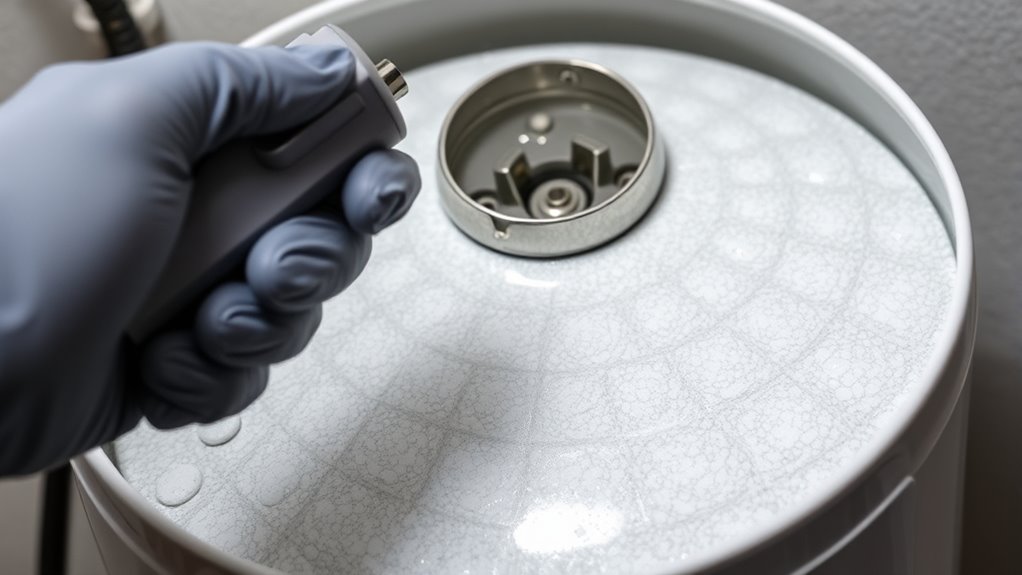
Regular maintenance is essential to keep high-calcium fill water from causing scale buildup and damaging your plumbing. You should regularly inspect and clean filters, as accumulated debris can worsen scale formation. Using water softeners or descalers on a routine basis helps reduce calcium levels, preventing scale from settling in pipes and appliances. It’s important to monitor water pressure and flow rates, as high-pressure systems can accelerate scale deposits. Flushing your system periodically removes mineral buildup and keeps equipment functioning efficiently. Additionally, applying scale-inhibiting treatments can provide ongoing protection. Implementing anti-scaling measures is crucial for long-term system health. Consistent maintenance not only extends the lifespan of your plumbing but also improves water quality and efficiency. Making these measures a routine part of your water management strategy minimizes long-term damage and keeps your system running smoothly.
Optimizing Plumbing and Equipment Design
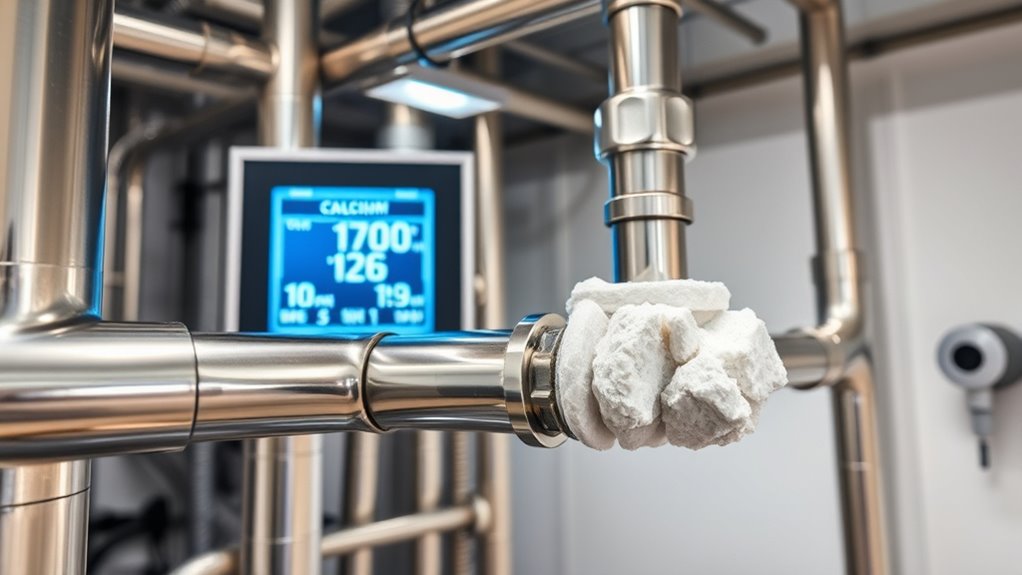
Optimizing the design of your plumbing system and equipment can markedly reduce the impact of high-calcium fill water. Proper layout minimizes areas where mineral buildup occurs, ensuring better flow and easier cleaning. Use corrosion-resistant materials like stainless steel or plastic to prevent scale adherence. Install water softeners or bypass systems strategically to reduce calcium exposure at critical points. Consider equipment placement to facilitate maintenance and cleaning. The following table highlights key design strategies:
| Strategy | Benefit | Implementation Tip |
|---|---|---|
| Use corrosion-resistant piping | Reduces scale buildup | Opt for PVC or stainless steel pipes |
| Incorporate bypass loops | Easier maintenance and cleaning | Install at key junctions |
| Install scale inhibitors | Minimize mineral deposit formation | Integrate chemical dosing systems |
Additionally, proper system design can play a crucial role in minimizing scale formation and ensuring longevity of your plumbing infrastructure.
Monitoring Water Quality Over Time

Tracking water quality over time is essential to managing high-calcium fill water effectively. Regular testing helps you identify trends in calcium levels, pH, and other minerals that can impact your system. Use reliable testing kits or hire professionals for precise measurements. Keep detailed records of each test to monitor changes and evaluate the effectiveness of your mitigation strategies. Pay attention to fluctuations that could signal issues like mineral buildup or equipment stress. Consistent monitoring allows you to catch problems early, preventing costly repairs or damage. Incorporate testing into your routine maintenance schedule, especially after implementing new treatments or system adjustments. Staying informed about AI advancements can also help you leverage new technologies for water quality management. By staying vigilant, you assure your water quality remains within ideal ranges, extending the lifespan of your equipment and maintaining system efficiency.
Adopting Sustainable Water Management Practices

To manage high calcium fill water sustainably, you need to optimize your water usage to reduce waste and conserve resources. Implementing natural filtration methods can help improve water quality without relying on harsh chemicals. Regular system maintenance guarantees your setup remains efficient and prevents calcium buildup that could cause issues down the line.
Optimize Water Usage
Implementing sustainable water management practices is essential for reducing water consumption and minimizing environmental impact. To optimize water usage, you should regularly monitor your water flow and identify areas where waste occurs. Installing meters and sensors helps track consumption patterns, enabling you to make informed adjustments. Reuse water whenever possible, such as recycling rinse water or capturing rainwater for non-potable uses. Fix leaks promptly to prevent unnecessary loss. Implementing efficient equipment, like low-flow fixtures or high-efficiency pumps, can considerably reduce water demand. Educate staff or household members about conservation habits, such as turning off taps when not in use. Additionally, understanding water flow management can further enhance efficiency and sustainability. By adopting these strategies, you ensure responsible water use, lower operational costs, and contribute to a healthier environment.
Implement Natural Filtration
Building on water conservation efforts, natural filtration methods offer a sustainable way to improve water quality without relying heavily on chemical treatments or energy-intensive systems. By harnessing natural processes, you can reduce calcium buildup and other impurities effectively. Here are three key approaches:
- Use gravel and sand beds to trap sediments and contaminants.
- Incorporate constructed wetlands to utilize plant roots and microbes for filtration.
- Install biofiltration systems that promote beneficial bacteria to break down minerals and organic matter.
These methods work together to enhance water clarity, reduce scaling, and promote eco-friendly water management. Implementing natural filtration not only supports long-term sustainability but also minimizes your reliance on chemical additives, making your water treatment more environmentally responsible.
Regular System Maintenance
Regular system maintenance is essential for sustainable water management because it guarantees your filtration systems operate efficiently and prevents issues like calcium buildup from escalating. You should inspect filters regularly, replacing or cleaning them as needed to maintain ideal flow and filtration. Check for leaks, corrosion, or blockages that could reduce system performance. Regularly calibrate your equipment to ensure accurate operation, and flush out the system to remove accumulated minerals. Maintaining proper water chemistry also helps prevent calcium deposits. By staying proactive, you extend your system’s lifespan and reduce costly repairs. Consistent maintenance creates a healthier water environment, minimizes waste, and supports long-term sustainability. Make it a habit, and you’ll keep your water system running smoothly while managing high calcium levels effectively.
Frequently Asked Questions
How Does High Calcium Affect Industrial Equipment Lifespan?
High calcium levels cause mineral buildup and scale formation inside your industrial equipment. This buildup constricts water flow, increases pressure, and puts extra strain on pumps and pipes. Over time, it accelerates corrosion and wear, shortening equipment lifespan. You might notice reduced efficiency and increased maintenance needs. To protect your equipment, you should implement water treatment solutions like softening or filtration, which help minimize calcium deposits and prolong operational life.
What Are Cost-Effective Long-Term Solutions for High Calcium Water?
You can save costs by installing ion exchange systems or water softeners, which efficiently reduce calcium buildup over time. Regular maintenance of these systems ensures peak performance and longevity. Consider blending softened water with raw water to balance quality and expenses. Implementing these solutions now prevents costly repairs and prolongs equipment life, making your investment worthwhile. Stay ahead by choosing these cost-effective, long-term strategies that keep your operations running smoothly.
Can High Calcium Levels Impact Water Taste or Odor?
Yes, high calcium levels can affect your water’s taste and odor. You might notice a chalky or metallic flavor, and sometimes a slight smell due to mineral buildup. These changes can make your water less appealing and may even impact your appliances over time. To improve taste and odor, consider installing a water softener or filtration system that reduces calcium and other mineral levels.
Are There Natural or Eco-Friendly Methods to Reduce Calcium?
Think of natural methods as gentle giants working behind the scenes. You can reduce calcium levels by installing an ion exchange water softener, which acts like a magnet for calcium ions, or use reverse osmosis filters to strip minerals from your water. Adding natural vinegar or lemon juice can help temporarily, but sustainable solutions like these eco-friendly options are your best bet for long-term calcium control.
How Does High Calcium Influence Energy Consumption in Water Systems?
High calcium levels cause mineral buildup in pipes and appliances, making them less efficient and increasing energy use. You might notice higher energy bills because water heaters work harder to heat water affected by scale. The mineral deposits hinder heat transfer, forcing systems to run longer and consume more power. Regular maintenance, water softening, and choosing energy-efficient appliances can help you reduce energy consumption caused by high calcium levels.
Conclusion
By understanding high calcium levels and choosing the right solutions, you naturally prevent scale buildup and extend your systems’ lifespan. Regular maintenance and monitoring become second nature, ensuring long-term water quality. Remarkably, as you adopt sustainable practices, you often find your water’s condition improves unexpectedly, revealing a seamless balance between efficiency and conservation. Ultimately, staying proactive and attentive transforms managing high calcium fill water from a challenge into an effortless part of your routine.


